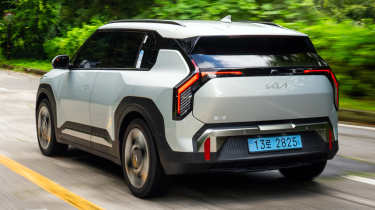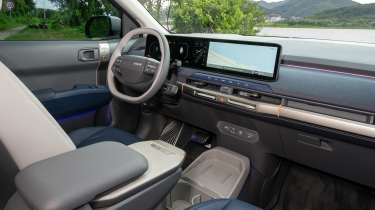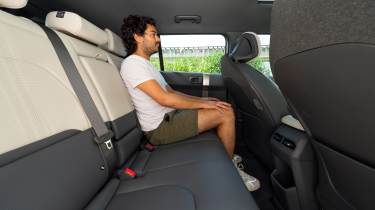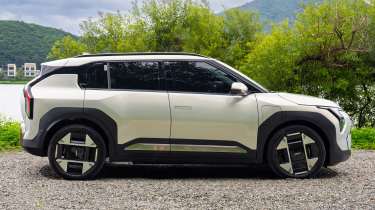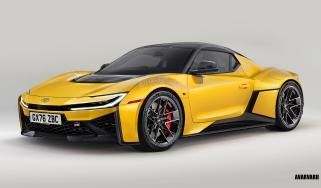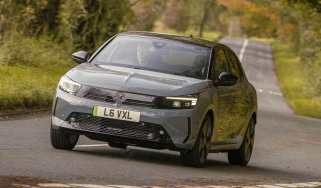Kia EV3 review
The EV3 is the next big step forward not just for Kia, but EV design and engineering at large

Is the Kia EV3 a good car?
Kia has a reputation for shaking up the electric car market. It did it first with the Kia EV6 and more recently the Kia EV9, but now the Kia EV3 has arrived to appeal to an even wider audience. It scores highly on efficiency, interior design and packaging, but there are still some question marks over the driving experience, which we’ll look at more closely when UK-specification models arrive. If Kia has sorted this for UK models, it’ll no doubt have hit the bullseye.
| Key specs | |
| Fuel type | Electric |
| Body style | Crossover SUV |
| Powertrain(s) | 81.4kWh battery, 1x e-motor, two-wheel drive |
| Safety | N/A |
| Warranty | 7yrs/100,000 miles |
How much does the Kia EV3 cost?
The Kia EV3 is offered in three trim levels and two battery sizes. Prices start at £32,995 for the entry-level Air model with a 58.3kWh battery, rising to £35,995 when specified with the larger 81.4kWh battery. The GT-Line and GT-Line S trims only come with the bigger battery pack, and prices for these trims kick off from £39,495 and £42,995, respectively.
A dual-motor option will be along later, but for now we’re driving the single-motor with the larger of the two batteries, which is expected to be the best-seller in the UK. Against key rivals such as the Volvo EX30 or Volkswagen ID.3, the Kia is competitively priced but comes with more equipment, and – in the case of the 81.4kWh battery – a longer range.
Engines, performance & drive
Much like the larger EV6, the EV3 feels well engineered and easy to drive. There’s also a refreshingly natural feel to the throttle and brake pedals that make them easy to acclimatise to. In fact, the brakes are particularly impressive, thanks to a consistent feel as they switch between friction and regenerative modes.
More reviews
In-depth reviews
Kia’s iPedal regenerative-braking system is one of the best in the business, and is controlled via steering-wheel paddles. As well as a ‘fully off’ setting, there are three levels of regenerative braking, plus an automatic mode that’ll vary the level of regeneration as you approach traffic lights or junctions.
Around town, there’s easily enough performance from the front-mounted electric motor, but it lacks eagerness when accelerating into traffic, with the kerbweight of almost two tonnes blunting performance despite it having 201bhp and 283Nm of torque.
There are four drive modes, but Sport is a bit misleading because it makes little difference to the amount of performance on offer. Instead, it’ll change the mapping of the throttle pedal to make it more responsive and add a bit of weight to the steering. There’s also Eco, Normal and a configurable mode that you can set up yourself.
The high kerbweight also has an effect on ride and handling. It’s comfortable for the most part, but can feel a little bouncy over undulations, while there can be quite a bit of body roll. That may not be hugely important for this type of crossover, but the EV3 isn’t a particularly sharp car to drive. Final judgement will have to be made once in the UK, though, because it will be tweaked for European markets compared with the Korean model on test here.
| Model | Power | 0-62mph | Top speed |
| Kia EV3 Air 58.3kWh | 201bhp | 7.5 | NA |
| Kia EV3 Air, GT-Line, GT-Line S 81.4kWh | 201bhp | NA | NA |
Range, charging & running costs
Battery-wise, the EV3 Long Range offers a relatively large capacity for the segment, at 81.3kWh, and combined with good efficiency, it’s one of the most capable long-distance EVs on sale. We averaged around 4.6m/kWh over a combination of city and motorway driving, albeit at no more than 62mph, which is the motorway speed limit in Korea where we conducted our test.
It did help the EV3 meet its advertised 372-mile official range, though, which is an impressive feat. We’d imagine the faster roads and cooler temperatures in the UK will see these figures drop, but Kia has still upped the range game in this class.
Top-up speeds are good if not great, with a peak DC charging rate of 128kW that'll replenish the battery from 10 to 80 per cent in around 30 minutes. Models with the smaller battery have a reduced charging rate of 102kW, but with less battery to charge, the 10-80 per cent top-up takes around the same time. Being a smaller and less expensive model than the EV6 and EV9, you don’t get a high-end 800V architecture, but the 400V set-up is still good.
| Model | Battery size | Range | Insurance group |
| Kia EV3 Air 58.3kWh | 51.8kWh | 267 miles | N/A |
| Kia EV3 Air, GT-Line, GT-Line S 81.4kWh | 81.4kWh | 372 miles | N/A |
Design, interior & technology
Kia’s interior design took a noticeable step up with the introduction of the EV9, and we’re pleased that the EV3 continues that trend. The overall ambience is modern, but not as minimalist as rivals such as the Volvo EX30 or the VW ID.3. Kia has retained rotating knobs for the audio volume, temperature and fan controls, which a lot of users will prefer.
The overall interior design strikes a balance between sleek and functional, without being austere. The materials aren’t plush, but everything feels well made and sturdy, with smart fabrics and, in the case of our GT-Line test car, soft synthetic leather-like material on the seats.
All EV3s are well equipped, with the top model featuring electric heated and cooled seats, an eight-speaker Harman-Kardon premium sound system, sunroof, powered tailgate and a 360-degree camera.
Sat-nav, stereo and infotainment
Most of the EV3’s functions are integrated into the digital interface. The set-up comprises three screens that are neatly integrated into one 30-inch wide housing. The driver’s display isn’t hugely configurable, but is clear and integrates Kia’s clever blind-spot monitoring camera system.
The smaller, five-inch screen beside it houses the heating and ventilation controls. This can be a little difficult to see from the driver’s seat, but the controls are large and accessible. The third screen features the main Kia infotainment system, which has a number of menus but is fairly intuitive to use.
Wireless Apple CarPlay and Android Auto are standard, as is a charging pad in the centre cubby. Beyond this, there’s also lots of room for storing smaller items, a big glovebox and superbly comfortable seats.
There are plenty of USB-C points dotted throughout the cabin and, as with other Kia EVs, you can even set the seats into a ‘relaxation’ mode when charging.
Boot space, comfort & practicality
| Dimensions | |
| Length | 4,310mm |
| Width | 1,850mm |
| Height | 1,570mm |
| Number of seats | Five |
| Boot space | 460/1,250 litres |
Space up front is excellent, and thanks to a low dash and big windscreen, visibility is great, making it easy to position the car on the road. In the rear, there’s also a decent amount of room and the flat floor allows for comfortable seating for three people. You won’t fit three child seats abreast, but the wide rear door apertures and large windows make for a pleasant back-seat experience.
At 460 litres, the boot is big for the class, with a false floor removing the load lip to create a flat load space, as well as a hidden underfloor cubby. The rear seats are split 60/40, and you can also adjust the backrest. Up front, the second boot under the bonnet is only 25 litres, but it makes for a handy place to store the charging cable.
Safety & reliability
| Key standard safety features | Euro NCAP safety ratings |
| NA |
Being such a new model in the marketplace, the EV3 hasn't been tested by Euro NCAP yet. But, when it does, we anticipate its comprehensive set of active and passive safety aids should mean an impressive result.
Kia also rates remarkably well for reliability across both of its EV and ICE ranges. In this year’s Driver Power survey, it actually ranked all the way up in third, behind only Subaru and Tesla – quite an achievement considering Kia’s breadth of models.
Kia EV3 alternatives
It’s hard to rationalise rivals based on whether they’re SUVs or not SUVs, but the main competitors for Kia’s EV3 will likely be the Volvo EX30, Volkswagen ID.3 and Cupra Born. All run on modern, EV-native platforms with a skateboard chassis underneath, and can offer over and above 300 miles on a charge.
However, all three have more variety in terms of powertrain options, with a powerful dual-motor option in the Volvo, and VW’s new GTX/Cupra’s Born VZ performance flagships. These aren’t really direct rivals for the EV3 yet, though – but we wouldn’t be surprised to see a GT model joining the dual-motor that we should see next year.
As an easy daily driver, the Volvo is attractive and comes with that very attractive badge, but its lack of interior space, plus the questionable interface surrounding the lack of physical buttons and switches will turn buyers off.
The Volkswagen and Cupra twins are much improved since their recent updates, though, but still trail the Kia on electric range, interior tech, and build quality. The Kia isn’t quite as sharp to drive as the Cupra Born, however.
Frequently Asked Questions
The EV3 has Kia’s generous 7-year, 100,000-mile warranty. This is miles ahead of most competition, and makes the Kia a very safe choice on the back of its inherent reliability.



